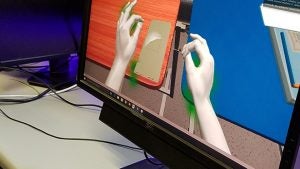The School of Nursing is partnering with the College of Innovation and Design, Department of Gaming, Interactive Media and Mobile Technology (GIMM) to create a virtual reality game and tool for nursing students.

Nursing students may soon have the opportunity to practice how to properly insert a sterile urinary catheter through virtual reality simulation. Karen Breitkreuz, associate professor for the School of Nursing, and Anthony Ellertson, program director of GIMM, have collaborated to create and test a virtual reality game that allows more hands on learning for future nurses.
“The game we have developed so far would allow students the opportunity to practice an important skill with sterile urinary catheterization as much as the student desired until they reach a competent level of proficiency,” said Breitkreuz.
The College of Health Sciences Simulation Center currently provides nursing students with the opportunity to work in full patient hospital rooms on manikins to practice using oxygen equipment, hospital beds, IV pumps, feeding pumps, etc. With the creation of this virtual reality game, students would be able to further their hands on learning with another way to practice and assess how to keep this procedure sterile. The games would also allow for a more affordable option compared to manikins in the Simulation Center.
“The advantage of the game is that it tells students when they make mistakes and how they can correct their own performance,” said Breitkreuz, “The thing we are trying to teach with this game, is how to prevent a sterile field from being contaminated and the basic steps to complete the procedure. In the game, the students see germs they don’t see in the practice lab and errors are pointed out in sterile technique the students make that can sometimes be missed.”

“The simulation ability and freedom of exploration will make virtual reality tools essential in higher education in the upcoming years,” said Mike Wilson, GIMM student. “I think virtual reality will become a part of every department here on campus, from nursing to physics. It offers functions that professors can use to evaluate their instruction.”